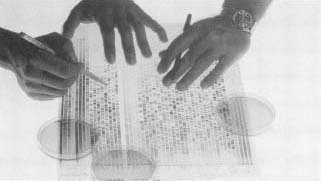Cloning
A clone is a group of genetically identical cells descended from a single common ancestor. Cloning is one method for producing identical twins. After an egg is fertilized, it begins to divide repeatedly. If the egg completely separates during the two-cell stage, identical twins will result. Both individuals will have exactly the same combination of genes (genotype) and each will have the same physical characteristics (phenotype). This is an example of how exact duplicates can naturally occur through sexual reproduction.
Science has capitalized on the mechanisms of cellular reproduction to produce clones. Advances in biotechnology since the 1970s have enabled livestock breeders to clone virtually unlimited numbers of identical animals from a single embryo. This allows the precise duplication of an animal with desired characteristics.
In 1979 veterinarian Steen Willadsen developed a way to divide sheep embryos in half at the two-cell stage, making clones possible. In the next few years, several scientists made further strides in this area with both sheep and cattle embryos. A team developed a simplified method of dividing and cloning sheep embryos in 1984.
Cloning is one area of genetics that is advancing very rapidly, and it is therefore very controversial. If this technology is ever applied to humans, who will decide which genes are "desired" and should be cloned? This is only one of many important questions that have arisen as a result of genetic cloning.

Dairy Farmers Use Cloning Techniques
As an example of cloning techniques, dairy fanners trying to clone a cow with high milk-producing qualities begin by artificially inseminating a high-producing cow with the sperm from a prize bull. The resulting embryo, which contains the entire genetic instructions needed to form a complete calf, develops within its mother. After some time, the embryo divides into a mass of 32 identical cells. The embryo is then carefully removed from the mother cow and separated into 32 separate cells. Finally, after microsurgery on the cells, each new embryo is transplanted into 32 different carrier cows, where it develops fully.
After a normal pregnancy, each carrier cow gives birth to a calf that is genetically identical to the 31 other calves derived from the original 32 cell embryo. Each calf is a clone. The trait for increased milk production has been cloned so that the farmer now has 32 high milk-producing cows instead of just one. Cloning technology has enabled breeders to develop lines of cattle, sheep, and cotton plants that respectively produce more milk, wool, and cotton.